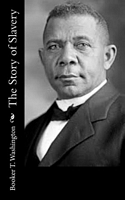- Welcome to FictionDB, Guest
- | My Account
- | Help

The Story of Slavery — Booker T. Washington

It was one hot summer's day in the month of August 1619, as the story goes, that a Dutch man-of-war entered the mouth of the James River, in what is now the State of Virginia, and, coming in with the tide, dropped anchor opposite the little settlement of Jamestown. Ships were rare enough to be remembered in that day, even when there was nothing especially remarkable about them, as there was about this one. But this particular ship was so interesting at the time, and so important because of what followed in the wake of its coming, that it has not been forgotten to this day. The reason for this is that it brought the first slaves to the first English settlement in the New World. It is with the coming of these first African slaves to Jamestown that the story of slavery, so far as our own country is concerned, begins.Although the coming of the first slave ship to what is now the United States is still remembered, the name of the ship and almost everything else concerning the vessel and its strange merchandise has been forgotten. Almost all that is known about it is told in the diary of John Rolfe, who will be remembered as the man who married the Indian girl, Pocahontas. He says, A Dutch man-of-war that sold us twenty Negars came to Jamestown late in August, 1619. An old record has preserved some of the names of those first twenty slaves, and from other sources it is known that the ship sailed from Flushing, Holland. But that is almost all that is definitely known about the first slave ship and the first slaves that were brought from Africa to the United States.The first slaves landed in Virginia were not, by any means, the first slaves that were brought to the New World. Fifty years before Columbus landed on the island of San Salvador, the first African slaves were brought from the West Coast of Africa to Spain, and we know from historical references and records that Negro slavery had become firmly established in Spain before Columbus made his first voyage. It was, therefore, natural enough that the Spanish explorers and adventurers, following close upon the heels of Columbus in search of gold, should bring their Negro servants with them.It seems likely, from all that we can learn, that a few Negroes were sent out to the West Indies as early as 1501, only eleven years after the discovery of America and one hundred and twenty years before the first cargo of slaves was landed in Jamestown. Four years later, in a letter dated September 15, 1505, written by King Ferdinand to one of his officials in Hispaniola, which we now call Hayti, he says among other things: I will send you more Negro slaves as you request. I think there be an hundred.
Genres
Click on any of the links above to see more books like this one.



